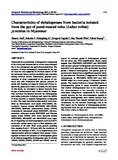Characteristics of dehalogenase from bacteria isolated from the gut of pond-reared rohu (Labeo rohita) juveniles in Myanmar

Associated URL
www.scirp.orgDate
2012Page views
463Metadata
Show full item recordCited times in Scopus
32 readers on Mendeley
- Citations
- CrossRef - Citation Indexes: 1
- Captures
- Mendeley - Readers: 32
Share
Abstract
Unwarranted accumulation of halogenated compounds in the rivers and streams has in recent years emerged due to the widespread use agricultural pesticides. The presence of these halogenated compounds in the water does not only suppress the immune system of fish but adversely induce serious morbidity and mortality among cultured stocks. Importantly, gradual accumulation of these compounds in the system of cultured and wild freshwater fish species cultured in ponds and floating net-cages in dams and rivers, respectively, poses some risks to humans, the end users. In this study, we attempted to isolate bacteria from the gut of pond-reared rohu (Labeo rohita) in Myanmar, screened the isolated bacteria for dehalogenase gene using molecular technique and tested the ability of these bacteria to degrade halogenated compounds in vitro. The eight bacterial strains studied were identified as Enterobacter mori strain MK-121001, Enterobacter cloacae strains MK121003, MK-121004, MK121010, Ralstonia solanacearum strain 121002, Acinetobacter baumannii strain MK121007, Chromobacterium violaceum strain MK121009 and Pantoea vagans strain 121011. Only three bacterial strains (MK121002, MK121007 and MK121009) were capable of degrading 2,2-dichloropropionic acid (2,2-DCP) as the sole carbon source up to a final substrate concentration of 20 mM. Their mean growth doubling time ranging from 6 - 23 hours with the maximum of chloride ion released of 85%. PCR amplification with oligonucleotide primers designed from group I dehalogenase revealed the presence of dehalogenase genes in all isolates suggesting dehalogenase gene in strains 121001, 121003, 121004, 121010 and 121011 were silenced. In contrast, group II dehalogenase primers did not show any PCR amplification. These results suggest that MK121002, MK121007 and MK121009 only encode a group I dehalogenase and its non-stereoselectivity is in agreement with previoulsly described group I haloacid dehalogenase. The partial gene sequences were blasted but no significant sequence identity was observed. Therefore, it suggests the 2-haloacid dehalogenase of MK121002, MK12-1007 and MK- 121009 might be a novel group I 2-haloacid dehalogenase. The results indicated a broad distribution of dehalogenation genes in many microbial genomes that harbor dehalogenase(s) due to the exposure of the microorganisms to the naturally occurring or man-made halogenated compounds in the environmental systems. So far, microorganisms capable of producing dehalogenases were mainly isolated from soil and scarcely from aquatic animals and their environments. To the authors’ knowledge, this is the first report on the isolation of dehalogenase-producing bacteria from the gut of pond-reared freshwater fish, Labeo rohita, in Myanmar.
Suggested Citation
Abel, E., Pakingking, R. V., Jr., Pagador, G., Wint, M. T., & Huyop, F. (2012). Characteristics of dehalogenase from bacteria isolated from the gut of pond-reared rohu (Labeo rohita) juveniles in Myanmar. Advances in Bioscience and Biotechnology , 3, 353-361. https://doi.org/10.4236/abb.2012.34051
Subject
Collections
- AQD Journal Articles [1248]

